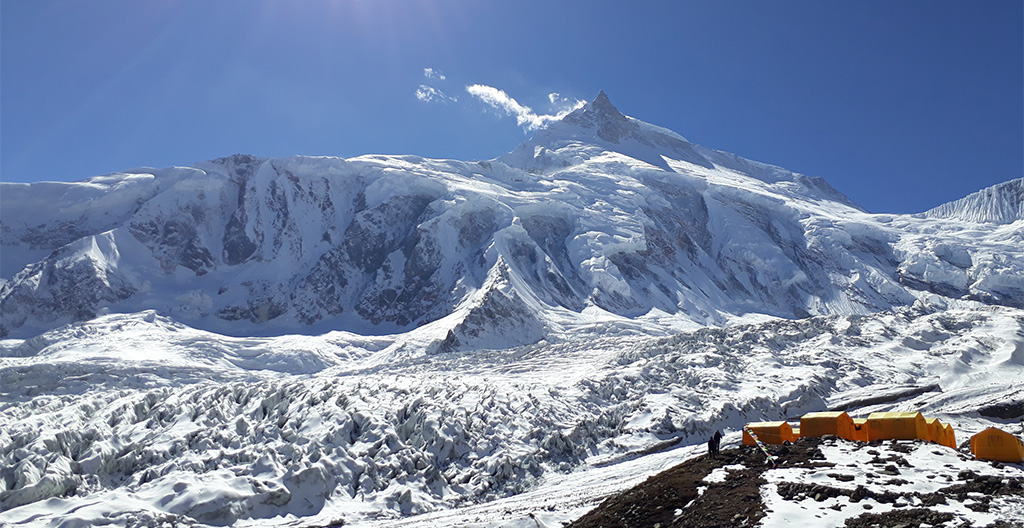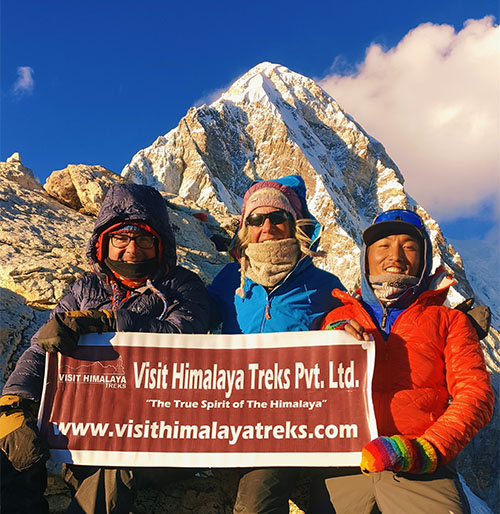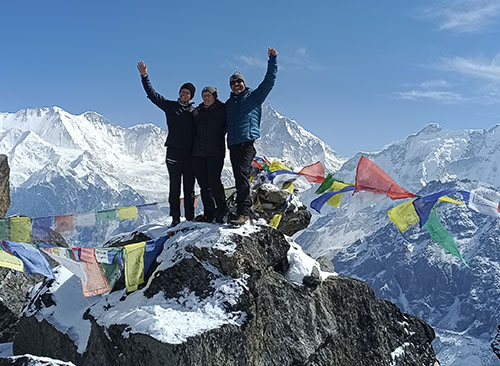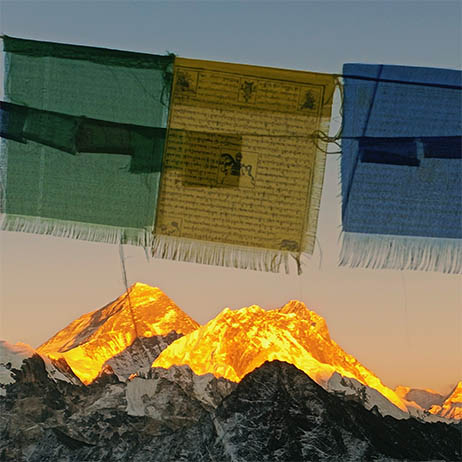Manaslu Circuit Trek is one of Nepal's most spectacular and off-the-beaten-path treks, appealing to trekkers looking to have a more remote and authentic Himalayan adventure. The trek circumnavigates Mount Manaslu (8,163m), the eighth highest mountain in the world, and the eighth highest mountain in the world, and features stunning scenery, Tibetan-laden cultures, glacial valleys, and one of the most picturesque high mountain passes in Nepal: Larkya La Pass (5,106m). But with such breathtaking dividends comes an element of challenge that calls for close focus. The Manaslu Circuit is not quite a meander through the hills; it is a challenging trek that tests physical stamina, acclimatization, and mental toughness, especially in its higher reaches.
Compared to more established trekking regions such as Everest or Annapurna, the Manaslu Circuit is relatively undeveloped, and this is both a blessing and a curse. The remote character of the region means fewer individuals and more wilderness, but also little infrastructure, multiple days of walking, and high-altitude ascents. The trek involves daily undulations in mountainous terrain, cliff-top trails, river crossings on suspension bridges, and is subject to changing weather systems. Acclimatization is the highest priority, especially as you approach the Larkya La Pass, where oxygen levels are much lower and altitude sickness might become a serious threat.
This blog explores in detail the true level of difficulty of the Manaslu Circuit Trek, segments the altitude problems, trail conditions, daily distance and elevation gains, fitness requirements, optimum times for safe travel, and recommendations for mental and physical preparation. Whether you are an experienced high-altitude trekker or a fit traveler looking to test your boundaries, knowledge of the complexities of the trek will allow you to prepare adequately for a safe, memorable journey on one of Nepal's most isolated trekking routes.
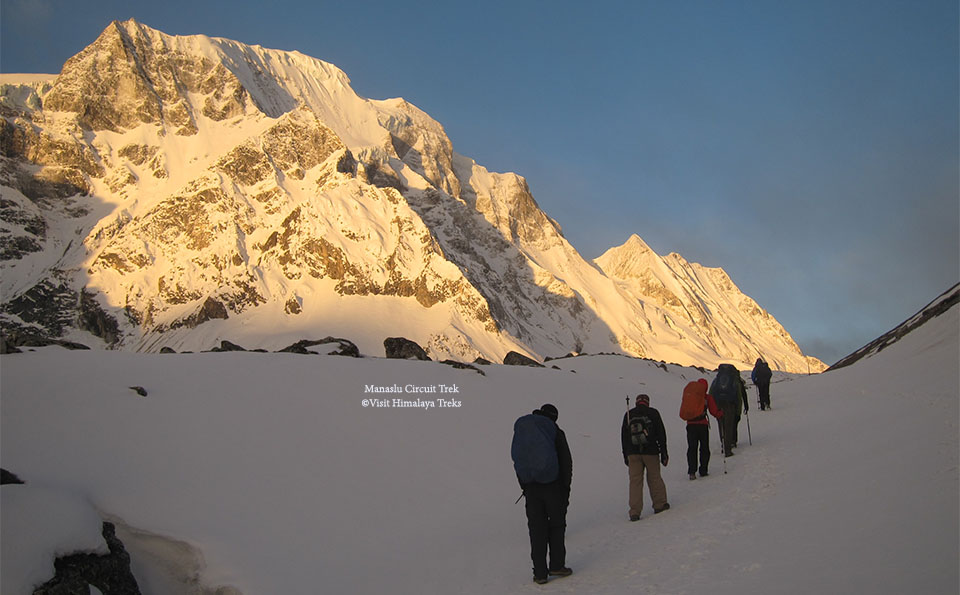
Manaslu Circuit Trek, en route to Larke La Pass (5106 meters)
1. Altitude and Acclimatization.
The highest point along the Manaslu Circuit Trek is Larkya La Pass at 5,106 meters (16,929 ft) altitude. Trekking at such a high altitude significantly reduces oxygen levels, which increases the likelihood of Acute Mountain Sickness (AMS). Although the path ascends gradually and gives your body some opportunity to acclimatize, the altitude remains one of the greatest challenges of this trek.
The body acclimatizes slowly to the thinner atmosphere, particularly after crossing above the height of 3,500 meters. Sama Gaun (3,530m) and Samdo (3,875m) are generally considered rest days of acclimatization in order to allow your body to adjust to it. Skipping rest days puts trekkers at severe risk from altitude sickness in the form of headaches, nausea, and fatigue.
- Highest Altitude: 5,160m at Larkya La Pass
- Risk from Altitude: Moderate to High (primarily above 3,500m)
- Prevention Strategies: Go slow, rest days, stay hydrated, and avoid drinking alcohol
- AMS Signs to Monitor: Dizziness, nausea, headache, breathlessness
2. Trek Duration and Daily Distance.
The average length of the Manaslu Circuit Trek is 13 to 17 days, depending on your starting and finishing points and how fast you trek. Generally, trekking days are 5 to 7 hours of walking, while the day for traversing the Larkya La Pass is 8–10 hours, so it is both the longest and most exhausting part of the trek.
Because the region is remote from any urban cluster and villages are miles apart, it is not possible to shorten or skip segments. This routine physical exertion for two or more weeks could lead to fatigue, especially in the absence of proper training.
- Average Trekking Time: 6–7 hours a day
- Longest Day: Larkya La crossing (8–10 hours)
- Challenge: Long walking hours, back-to-back trekking days
3. Terrain and Trail Conditions.
The trail on the Manaslu Circuit is natural, harsh, and physically demanding. It begins with lowland terraced lands and forests, gradually rising to alpine meadows, glacier moraines, and snowy high passes. Trekkers must cross multiple suspension bridges, pass through landslide areas, and climb often narrow cliffside trails.
At higher elevations, especially around Larkya La, the terrain is rocky, icy, and potentially snowy, especially in early spring and winter. Although the route is well used, it's not as well maintained as commercial routes like Everest or Annapurna, so sturdy trekking boots and poles are required.
- Trail Type: Varied forest paths, rocky ridges, alpine environments.
- Hazards: Loose rock, snow, ice, landslides, and stream crossings.
- Gear Tip: Trekking poles, waterproof boots, and gaiters during winter months.
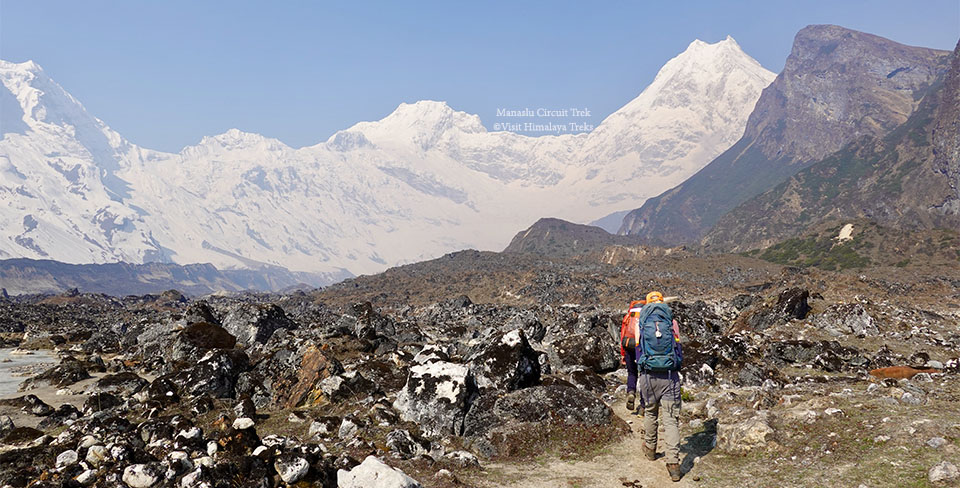
Mount Manaslu view seen en route to the Manaslu Circuit Trek,
4. Weather Conditions.
The weather is one of the most significant factors that decide the comfort and safety of the Manaslu Circuit Trek. It changes dramatically with the seasons, affecting visibility, trail conditions, and trekking comfort in general.
Autumn (Sept–Nov): Perfect time – clear skies, stable weather, minimal snow.
Spring (Mar–May): Good views, rhododendrons blooming, chance of snowfall at high altitude.
Winter (Dec–Feb): Sub-zero temperatures, snowed-in trails, chance of Larkya La closure.
Monsoon (Jun–Aug): Muddy paths, heavy rain, leeches, and extreme risk of landslides.
Weather conditions change abruptly in the Himalayas, especially afternoons. Always have waterproof layers and monitor day-to-day weather forecasts through your guide or teahouse operators.
Weather Impact: Significant impact on safety, speed, and enjoyment.
Important Tip: Trek during high seasons (Autumn or Spring) to have the best experience.
5. Remoteness and Logistics.
The Manaslu region is far more remote than that of Everest or Annapurna. Once you leave the lower villages, you will have very little access to medical care, internet, and a phone signal. There are fewer tea houses, and some are quite basic when it comes to food, heating, and sanitation.
In the event of an emergency, escape from upper Manaslu is only possible by helicopter evacuation, costly and weather-permitting. This remoteness adds an element of adventure but also increases risk factors, especially for the inexperienced traveler or one without a guide.
- Medical Facilities: Very primitive; have a first aid kit on hand.
- Connectivity: No signal or Wi-Fi in upper sections (especially between Samdo and Larkya Phedi).
- Logistics: Permits have to be booked in advance through a licensed agency.
- Tip: Bring water purification tablets, emergency snacks, and general meds.
6. Physical Fitness Requirements.
You don't have to be a pro athlete, but good physical condition is required. Good cardiovascular capacity, leg strength, and mental toughness will serve to combat the many hours of walking, mixed terrain, and altitude.
A pre-trek training program should include backpacking, cardiovascular training in the form of jogging or cycling, and leg and core strength training. The fitter you are, the more you'll enjoy the trek and recover from it.
- Training Recommendation: 6–8 weeks' preparation, altitude simulation where feasible.
- Health Tip: Trek on your own terms, don't rush through to avoid exhaustion and injury.
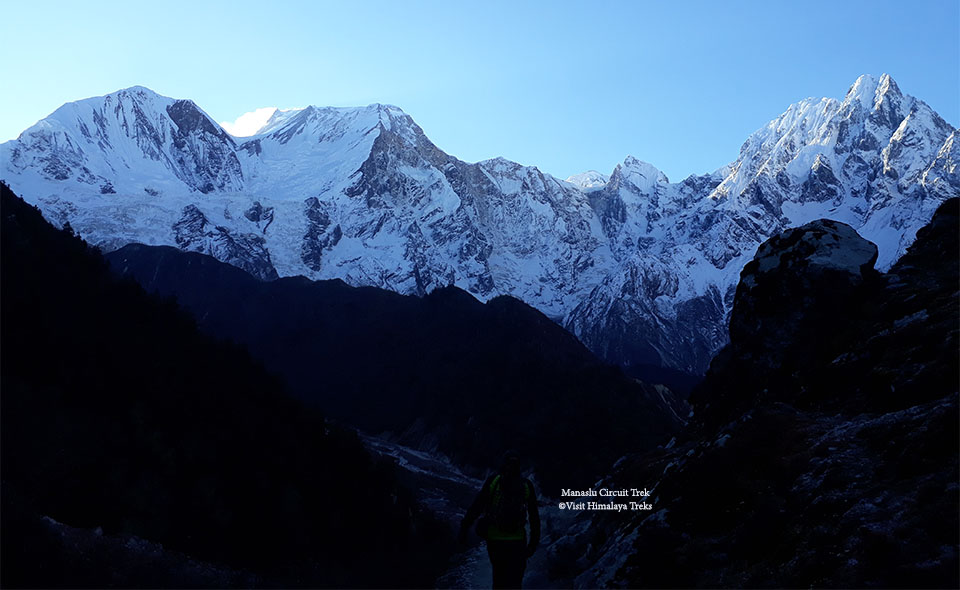
Wonderful Himalayan View, en route to the Manaslu Circuit Trek.
7. Guided vs. Independent Trekking.
Since the Manaslu area is a Restricted Area, solo trekking is not allowed. You must have two trekkers as a minimum group and one licensed guide. Trekking agencies will also arrange all the necessary permits: MCAP (Manaslu Conservation Area), ACAP (Annapurna Conservation Area), and the Restricted Area Permit.
Touring with a guide not only complies with legality but also highly improves safety, cultural awareness, and trail maintenance. Your guide is able to help with altitude sensitivity, language, emergencies, and sleeping arrangement bookings.
- Guides: Necessary-acquire them licensed and experienced on Manaslu.
- Permits: Cannot be acquired independently—have to go through a registered agency.
- Tip: Acquire an agency with prior experience on isolated treks like Manaslu.
Conclusion
The Manaslu Circuit Trek is an adventurous and once-in-a-lifetime experience traveling through one of Nepal's most beautiful and ethnically rich regions. The combination of altitude, landscape, isolation, and length renders it best suited to experienced trekkers who have a sense of adventure. If you are willing to ditch commercial trails for a world of mountain tranquility, Buddhist monasteries, and unspoiled wilderness, then the Manaslu Circuit won't disappoint. With good planning, an experienced guide, and a solid mental outlook, you'll conquer not just Larkya La, but an internal feeling of victory and self-discovery.
FAQs
1. How difficult is the Manaslu Circuit Trek?
The Manaslu Circuit Trek is graded as moderate to challenging, and this is perfect for physically fit trekkers who possess some experience in high-altitude trekking. The trek features extended walking hours, isolated mountainous country, and a very tough climb up to Larkya La Pass (5,160m). Adequate physical fitness, sheer determination, and good acclimatization are the keys to the successful completion of this trek.
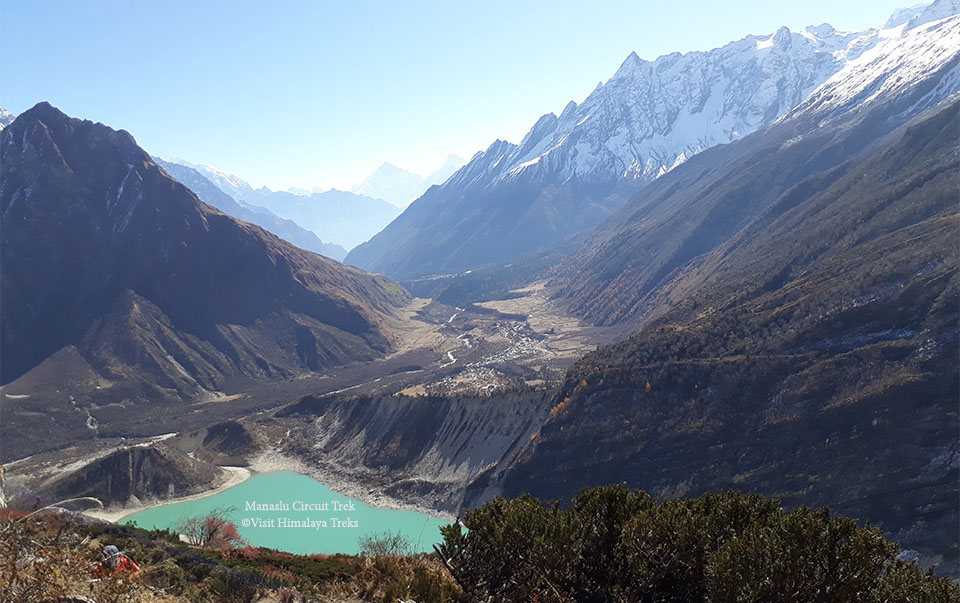
Birendra Lake View from Manaslu Circuit Trek Route.
2. Is a guide necessary for the Manaslu Circuit Trek?
Yes, you need an official guide. Manaslu is a Restricted Area, and treks are not permitted independently. You need to trek with a registered government guide and as a group of at least two trekkers.
3. What is the Best Time to Do the Manaslu Circuit Trek?
The best time to visit for the Manaslu Circuit Trek is:
- Autumn (September-November): Favorable climate, clear sky, and good views of the mountains.
- Spring (March-May): Blooms of rhododendron, pleasant climate, and occasional snowfall at higher elevations.
- Avoid the monsoon season (June to August) due to intense rain, slippery trails, and landslides. Winter (December-February) is only suitable for well-equipped and experienced trekkers due to low temperatures and snowy passes.
4. Is altitude sickness a risk on the Manaslu Circuit Trek?
Altitude sickness is a potential danger, especially because the trek ascends to well above 3,500 meters. Your body has to acclimate to thinner air, and acclimatization days in villages like Sama Gaun and Samdo are necessary. To reduce the risk of AMS, it is highly recommended to have a relaxed itinerary, drink lots of fluids, have enough carbohydrates, and be aware of headaches, dizziness, or nausea.
5. Are there tea houses along the Manaslu Circuit Route?
Yes, simple tea houses are available in all villages along the Manaslu Circuit Route. They offer basic rooms, typically with shared toilets and minimal heating (only in the dining area). They are not as developed as in the Everest or Annapurna regions, but offer sufficient shelter and food to the trekkers.
6. How do I physically prepare for the Manaslu Circuit Trek?
Physical preparation is the key to experiencing and completing the Manaslu Circuit Trek. Training suggestions are:
- Cardiovascular training: Running, cycling, or swimming to enhance endurance.
- Stair climbing or hiking with a heavy pack: To simulate trekking conditions.
- Strength training and endurance exercises: To strengthen your legs and core.
- Start training a minimum of 6 to 8 weeks before your expedition. Prior experience in trekking, especially at higher elevations, is a valuable advantage.

